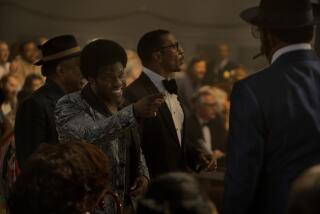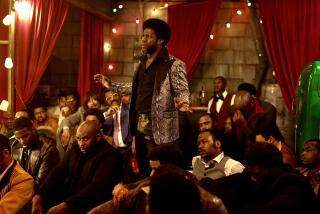Light Touches
LAS VEGAS — Bob Foster hunched over in the locker room and began to put on his shoes. “Where are you going?” asked his trainer, Billy Edwards.
“I’m going out there to fight,” Foster said.
“Son,” replied Edwards, “the fight’s over.”
And so what had begun as a dream ended in a punch-induced fog. Light-heavyweight champion Bob Foster’s dream of beating Muhammad Ali to win a heavyweight title ended in a knockout loss in the eighth round of their 1972 fight in Stateline, Nev.
Others have had that dream. When light-heavyweight champion Roy Jones steps into the ring at Thomas & Mack Center on Saturday night to challenge World Boxing Assn. heavyweight titleholder John Ruiz, Jones will become the 15th light-heavyweight to challenge for a heavyweight crown in his first major heavyweight bout. Bob Fitzsimmons also fought for the heavyweight crown as a middleweight.
Only two of the previous 15 have been successful. Fitzsimmons took the heavyweight title from Gentleman Jim Corbett in 1897 and Michael Spinks, a light-heavyweight, became heavyweight champion when he defeated Larry Holmes in 1985.
The average weight discrepancy in the 15 fights was 17.8 pounds. The biggest was the 86-pound edge 270-pound Primo Carnera had over Tommy Loughran in 1934, yet Carnera was unable to knock Loughran out, winning instead by decision.
“It takes a lot out of you to fight those big, old heavyweights,” said Foster.
The stories of a few of those who did follow:
Bob Fitzsimmons
An Englishman who fought 62 matches from 1883 to 1914, Fitzsimmons went through several weight divisions. As an amateur, he once entered a tournament as a 140-pounder but wound up winning the heavyweight division.
In 1891, Fitzsimmons won the middleweight championship -- there was only one in those days -- defended it only once and then began fighting heavyweights with an eye on the title.
Fitzsimmons got his chance on March 17, 1897, against Corbett in Carson City, Nev. Although Fitzsimmons was facing an unbeaten (13-0) champion, was four years older than Corbett at 34, was 16 pounds lighter at 156 1/2 and was bleeding badly by the 14th round, he somehow reached back and landed a devastating blow to Corbett’s stomach that took the wind out of the champion and the title out of his possession.
The knockout blow, described by ringside reporter Robert H. Davis, was reprinted in the Book of Boxing.
“Corbett appeared to be standing still,” wrote Davis, “but such was the speed and violence of the blow that Fitzsimmons’ left arm seemed to disappear into Corbett’s midst almost to the elbow. A groan came from Jim’s open mouth. He strained as though stricken with lockjaw, the whole upper body retching in apparent effort to reassemble the bodily functions and start to live again.”
Fitzsimmons didn’t return to the ring for two years, and, when he finally did, he lost his heavyweight crown to Jim Jeffries on an 11th-round knockout.
Fitzsimmons went on to win the light-heavyweight title at 40, but it was for his victory over Corbett that he would be best remembered, especially since it would be 88 years until someone equaled his feat.
Billy Conn
Conn’s challenge was perhaps matched only by that of Foster. These two light-heavyweights were not only trying to win a heavyweight title but trying to do so against arguably the two greatest heavyweights of all time. For Foster, it was Ali. For Conn, it was Joe Louis.
Conn began his professional career as a 16-year-old lightweight in 1934 and, in just seven years, was fighting Louis at New York’s Polo Grounds.
And winning.
Although the 169-pound Conn was giving away 30 pounds to Louis, Conn had retained his speed and dancing ability, skills that enabled to him pile up a lead on two of the three scorecards through 12 rounds with the fight even on the other card.
But in the 13th round, Conn got greedy and got knocked out.
Moving in for what he hoped would be the kill, Conn exposed his jaw and Louis crushed it with his legendary right hand, knocking out Conn.
Conn, according to “The Great Book of Boxing,” later told Louis, “You should have let me win. Then I could have held the title for a year and, when we had a rematch for a lot of money, you could have won it back.”
Replied Louis: “How could you hold it for a year? You had it for 45 minutes and couldn’t hang onto it.”
The two fought again in 1946 and again Louis won by knockout, this time in the eighth round.
Bob Foster
Foster fought a whole line of heavyweights, from Ali to Joe Frazier to Ernie Terrell to Doug Jones to Zora Folley.
And lost to all of them.
It wasn’t because Foster was a poor fighter. He was a dominating lightweight, the undisputed champion of his division from 1968-74. But he discovered that when he gave away pounds to the heavyweights, he also gave away the advantage his boxing skills and punching power afforded him against his ring equals.
Frazier knocked Foster out in the second round of their 1970 match in Detroit.
“I had a lot of punching power,” said Foster. “But there was a lot of difference fighting a heavyweight.”
Foster figured at first that he could beat Frazier by bulking up. “I got up to 195,” Foster said, “but I started feeling sluggish. I just couldn’t bear the weight.”
So he took it off, but he didn’t want Frazier to know. At the weigh-in, Foster stepped on the scale and was officially listed at 188.
It was a sham. Underneath his trunks, he was wearing a weighted belt. He was actually 178.
Foster’s mind games had little effect on Frazier, who weighed a legitimate 209. Once the bell rang, Frazier exposed Foster for the light-heavyweight he was.
“I hit Frazier with two right hands, back to back, that if I had hit the average light-heavyweight, I would have knocked him out,” Foster said. “But he did not go down. I knew then I needed to get out of there. When Joe started to put pressure on me in the second round, I was in trouble. But you can’t change your style.
“He caught me with a left hook that caused pain from the top of my head to the bottom of my feet. I sprained my ankle because he hit me so hard, my body turned, but not my left foot. I didn’t know where I was for two days.”
Foster had better luck against Ali, opening up cuts over one of Ali’s eyes and under another and bloodying his nose before finally succumbing to the heavyweight’s speed and power.
“I sure am glad Foster couldn’t gain another 10 or 15 pounds,” Ali said, “because he hit hard.”
Even in defeat, Foster wasn’t fazed by the big men he faced.
“I was never afraid of nothing,” he said. “I would have fought King Kong if the money was right. I hurt Frazier in the first round, I had Ali wobbling. I just couldn’t finish them.”
Michael Spinks
When Larry Holmes entered a ring at Las Vegas’ Riviera Hotel on Sept. 21, 1985, he was finally within reach of the man he had been chasing throughout his seven-year reign as heavyweight champion: Rocky Marciano.
Marciano had retired as the only undefeated heavyweight champ at 49-0. When the bell rang that night, Holmes was 48-0.
And it was widely assumed he’d catch Marciano since, at 223 pounds, he outweighed Spinks by 18. Yes, Spinks was 27-0, the class of the light-heavyweight division. But now, Holmes figured, Spinks was about to learn the same hard lesson absorbed by all the other light-heavyweights of the 20th century who had tried to play with the big boys.
Instead, it was different this time. Jabbing and moving and staying out of the line of fire of Holmes’ devastating jab, Spinks won a controversial decision.
Outraged, Holmes demanded and got a rematch a year later. In the second fight, he caught Spinks on the ropes in the 14th round with a right hand that stunned the newly crowned heavyweight king. But Spinks survived to win another decision.
Spinks won two fights before finally running into a heavyweight who was too overpowering for him, Mike Tyson, back in the days when he trained and moved and boxed. In 1988, Tyson stopped Spinks 91 seconds into their bout.
Spinks never fought again.
He had proved that a light-heavyweight could beat a heavyweight champion. But he had also proved that it couldn’t be done against overwhelming power like that of Tyson.
Foster, facing up to reality all these years later, said, “You can’t change your punching power.”
*
(BEGIN TEXT OF INFOBOX)
Jones vs. Ruiz: The Oddities
* Roy Jones, 34, is attempting to become the second light-heavyweight champion to win the heavyweight championship after Michael Spinks, who defeated Larry Holmes in 1985.
* Jones (47-1, 38 knockouts) also has held versions of the middleweight and super-middleweight titles and is attempting to become the first middleweight champion to win the heavyweight championship since Bob Fitzsimmons won the title from Gentlemen Jim Corbett in 1897.
* Michael Spinks, who defeated Larry Holmes in 1985 and again in their rematch a year later, had less trouble but was of a similar height and reach to Holmes.
More to Read
Go beyond the scoreboard
Get the latest on L.A.'s teams in the daily Sports Report newsletter.
You may occasionally receive promotional content from the Los Angeles Times.










